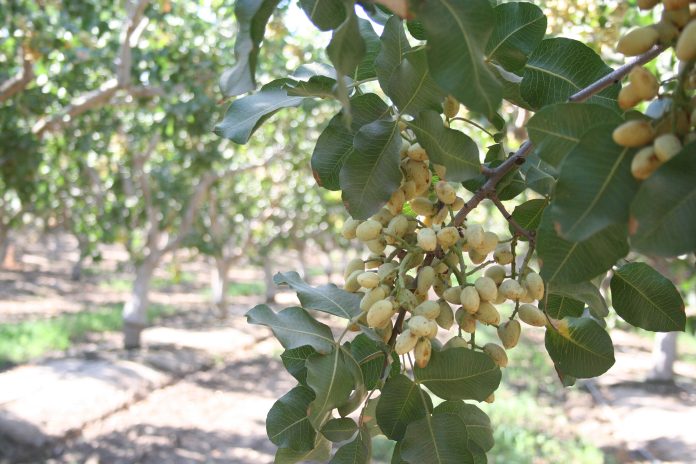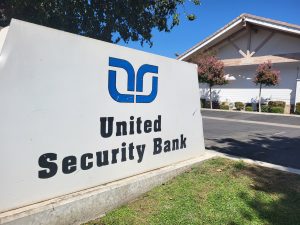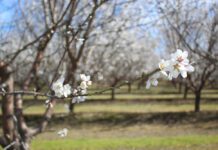
Not many pistachio growers head to work every day in a suit and tie. But Dennis Woods is no ordinary pistachio grower.
Besides overseeing his 300 acres of pistachio orchards in west Fresno County, Woods is chairman, president and CEO of United Security Bank, a Fresno-based financial institution with 11 branches in California’s Central Valley. Moreover, since January 2022, he’s served as chairman of the board of the 800-member American Pistachio Growers organization.
Those diverse roles force Woods “to be a bit of an encyclopedia of data concerning the valley,” he says. With his financial acumen, industry experience and what he calls the “avalanche” of information that crosses his desk each day, Woods has developed unique insights into California’s tree nut industry. In September, he shared some of those with West Coast Nut.

Q. Why accept the chairmanship of American Pistachio Growers when you already have three big jobs with United Security plus your own pistachio orchards to oversee?
I have been a pistachio grower personally for just over 40 years and obviously am interested in this industry. I’ve also dabbled in grapes and almonds, but I settled on pistachios. Through my role at the bank, we have financed pistachio farmers for more than 30 years. Half of the bank’s board members are also pistachio growers. So, this is something I touch every day of my life. Plus, I like to stay busy. That makes my day move quickly.
Q. In September, the Federal Reserve approved its third consecutive interest rate hike in 2022. Many expect more interest rate increases before year’s end. How will these higher interest rates impact farm borrowers?
The September increase pushed us up almost 3% this year alone after being flat for nine years. Huge, huge difference. They have to raise the interest. That’s the only lever the Federal Reserve has to slow the economy.
When you go to get a farm loan, you have to give a budget. If you’re paying 3% on $1 million, that’s $30,000. If you’re paying 7%, it’s $70,000. A lot of new farmers and new expansion won’t qualify for their loans.
Then, along with that budget, if your labor that used to be $10 an hour is now $20 an hour, and all the petroleum products like fertilizers and pesticides are up 20%, 30%, 40%, all of a sudden (in once profitable farming areas of the Central Valley), it’s now going to get to be marginal. Farmers with debt and new farmers are going to have a problem going forward.

Q. Even pistachio growers?
Even pistachio growers. Our price has been pretty stable, and even if our volume is going up, that’s mostly because of new acreage coming into production. What you’re producing as a farmer, 200,000 pounds of pistachios, pick a number, you’re selling for $2.40 a pound. If your costs for water, labor, chemicals go up, even if you can hold the price, your margin keeps shrinking. Your property tax, workers comp, payroll taxes, wages go up. So, essentially for people who are passing farms down from generation to generation, what was a wonderful business for the grandparents is maybe not even a break-even business for the grandkids. That will be sad.
Q. What are your priorities on APG’s board, especially with California’s water situation?
As a board, we know that California’s pistachio volume, which is 1 billion pounds a year, is going to grow over the next five years. Overplanting and oversupply have affected the almond industry, which is having challenges. We are at sort of an equilibrium. Our volume three years in a row has been almost flat, and our price has been almost flat. But we have to work harder to not have the same challenges that other nut and other commodities are having. It is going to be work.
One positive is that a pistachio tree can last more than 100 years, unlike almonds that have to be replanted every 20 to 25 years. What’s in the ground today will be here when my grandchildren are running my farm. Another positive is that a pistachio tree is a desert plant that takes less water and lesser-quality water than almonds or other crops. I happen to farm in the Westlands Water District, which is the largest irrigation district in the country. There are thousands and thousands of almond trees being pushed over because there isn’t enough water and the quality of the water isn’t good enough. So, we have a real challenge with water. As an organization, we are focused on that.
But we also see market opportunity with the pistachio being the complete protein of the nut groups. It doesn’t require refrigeration or cooking. There are also a huge number of vegetarians globally that buy our products, such as in India. We think pistachios have a very universal appeal.
Q. Looking two to three years down the road, what’s your forecast for pistachio prices?
You like to think they’re going to go up a few percent a year. But what we know for sure is our volume is going to go up substantially. I would say prices may not go up from here. This might be the top.
Today, prices for open-shell nuts are around $1.80, and the meats are in the $2.50 range. Then with good marketing luck the following year, you have maybe as much as a 20% bonus. So, when you put that altogether, it’s maybe $2.25 a pound all in, this year and next year. We have had a very controlled carryover from crop to crop. But we know in the next four or five years if we can’t continue penetrating into new markets, and I’m talking international, we will have the same challenges that almonds have currently. We have to focus on how not to follow the same path.
Q. What do growers most often ask you about?
Mostly when farmers come to the bank, they want to know that either they can get a development loan or an annual crop loan. Because we have a responsibility to protect our bank and our shareholders, we must have that discussion that’s never comfortable: “Your budget is making these projections. And I know from looking at 30 other farmers’ budgets, projections and tax returns, that what you’re putting on paper isn’t realistic.” That’s the conversation you hate to have.
But I always feel I’m a resource for our customers because nobody else gets to look at the balance sheets and tax returns of dozens of growers. We have to see those because they’re asking us to give them millions of dollars to keep their farms going. And so, maybe more than anybody (government, industry, whatever), I may have more information that I can share with my customers. And because half of my board members also grow pistachios, we’re a pretty good information bank.
We’re still very bullish for people who are well capitalized. But what all banks are looking for now, and most farmers too, are two minimum but probably three sources of water.
As a local bank in Central California, we’re able to make suggestions they may or may not be able to meet but that would allow us to keep lending to them. My goal is how to turn a no into a yes. I would say over the 35 to 40 years we’ve been open, we’ve probably approved 95% of our applications. Often, I like to at least give them a counterproposal so it’s not us saying “no.” The customer may say, “I’m not willing to take that risk. That’s going to be too hard for me.” But they get to make the decision. I never want to put somebody out of business.















